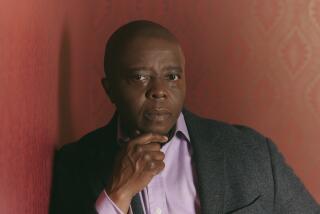Amid Baltimore unrest, new film challenges a popular police weapon

Director Nick Berardini attends the April 17 premiere of “Tom Swift and His Electric Rifle” during the 2015 Tribeca Film Festival New York City. The documentary, whose name is the acronym for “taser,” explores the use of police force.
- Share via
When Nick Berardini was a senior at the University of Missouri, he learned of the story of Stanley Harlan. Harlan, 23, had been shocked with a Taser by police for more than 30 seconds after a routine traffic stop outside his home in Moberly, Mo., in 2008. Harlan died on the scene while his mother looked on.
Berardini began looking into the incident shortly after it happened, using his camera, interviews and archival footage to explore the circumstances surrounding Harlan’s death. It soon led him to a much larger investigation of similar incidents around North America, and eventually to the company that manufactures Tasers.
Nearly seven years later, Berardini has put the results on screen in “Tom Swift and His Electric Rifle,” a new documentary that premiered at the Tribeca Film Festival earlier this month and aims to roll out to TV or theatrical audiences shortly.
As the strife in Baltimore has intensified, so too has the debate over the proper use of force by police officers -- all stemming from the incident in which 25-year-old Freddie Gray died under unclear circumstances while in police custody. “Tom Swift” injects itself into this larger narrative, arguing that one preferred means of policing is deeply flawed and should be both more extensively studied and severely restricted.
“Taser has in a sense already won because there are so many of their weapons on the streets,” Berardini said in an interview. “The message of the film is to have us take a look at the issue. Are we comfortable with how we got here? And if not, should we rally against it?”
Founded in 1991 by the brothers Rick and Tom Smith (who worked off research 20 years before by a man name Jack Cover), Taser International Inc., has grown into the predominant supplier of so-called electrical weapons to police officers. About 1 million Tasers are now used by law-enforcement departments around the world, who embrace the Smiths’ argument that by causing suspects to be incapacitated, the weapon both protects the officers and prevents suspects from absorbing more deadly force.
Into this world comes Berardini, who painstakingly builds a case against the company and argues that the lightly regulated weapon -- often thought of as a significantly more desirable alternative to firearms, not just by police but by the general public -- needs far more official oversight. By examining the deaths of suspects in Taser-related incidents — according to some accounts they exceed 300 — the film makes a logical plea bolstered by some very emotional back stories. Berardini shows that not nearly enough research has been conducted on the effects of the weapon, and that much of the research that has been done is subjective and specious.
The Smiths, for instance, are fond of saying that they performed tests on themselves before mass-producing the device. But Berardini secures documents that show that most of these so-called tests were tases of as little as half a second, while many police officers routinely use it for far longer periods.
And in any event, the film says, a Taser is far more dangerous when used on people with medical conditions — a fact that police officers in most situations will neither inquire about, nor even know about, before firing the weapon.
Most fundamentally, the film argues that the Taser, far from saving lives, enables a kind of lazy policing. Since an electrical weapon is less deadly than a conventional firearm, many officers will reach for one automatically when even less harmful methods, such as talking to a suspect, are available -- and even when the officers are in no imminent danger -- the film says.
“The easiest way for police to control a situation is by ending it with force quickly,” Berardini said. “And is that really the best way to do it?”
For their part, the Smiths see nothing but lifesaving benefits to their product. Among other things, “Tom Swift and His Electric Rifle (the title is an allusion to the words that “Taser” acronymizes) is an object lesson in corporate spin. The brothers can be seen in archival material, testifying before several commissions (Berardini landed an interview with company spokesman Steve Tuttle, but not with them). The Smiths maintain throughout that “there is absolutely no basis” that Tasers contributed to many of these deaths.
Of course, such specific causal links are hard to prove — it’s technically possible but highly improbable that heart attacks occurred coincidentally at the exact moment that many people were tased — and the Smiths’ continual parsing of investigators’ questions both to evade the issue and satisfy the narrowest conception of truth turns the movie into a kind of study in Orwellian doublespeak.
Or as John Burton, a Pasadena lawyer who specializes in cases against the company, put it, “I couldn’t believe the … they were saying.”
A Taser International spokesman did not immediately respond to a request for comment.
Harlan’s case, captured on bystander-taken video, exerts a particular emotional pull. He seems to be complying with officers, who at several points even are seen calmly chatting with him. But for reasons that are unclear, they soon begin tasing him. He dies immediately afterward. (The Moberly Police Department settled a lawsuit by Harlan’s family for more than $2 million the following year and clamped down on Taser use.)
A similar circumstance befalls a Polish immigrant named Robert Dziekanski at the Vancouver airport in 2007. Dziekanski is engaged in a miscommunication inside the airport’s secure area when he begins growing frustrated with an inability to be understood. In disturbing user-generated video seen in the film, officers pull their Tasers and repeatedly shoot him. Dziekanski dies shortly afterward.
The incident led to a massive investigation that faulted the officers, and Berardini said he feels there is a growing awareness about the dangers of Tasers and even some efforts to regulate the weapon.
That doesn’t mean the issue has gone away. Two days before Gray died, another Baltimore man died in policy custody after being tased by officers. And in a discomfiting turn, the stock of Taser has shot up in the wake of the Baltimore riots.
Ultimately Berardini says that he hopes this film contributes to an awareness that police are misguided in their reliance on the weapon and motivates a much harder look at Taser usage.
“It’s not realistic to pull a weapon that is so common away from police officers all at once,” he said. “But we need not to take what the company is saying at face value. We need to take the first step in understanding what a Taser is.”
Twitter: @ZeitchikLAT
More to Read
Only good movies
Get the Indie Focus newsletter, Mark Olsen's weekly guide to the world of cinema.
You may occasionally receive promotional content from the Los Angeles Times.









